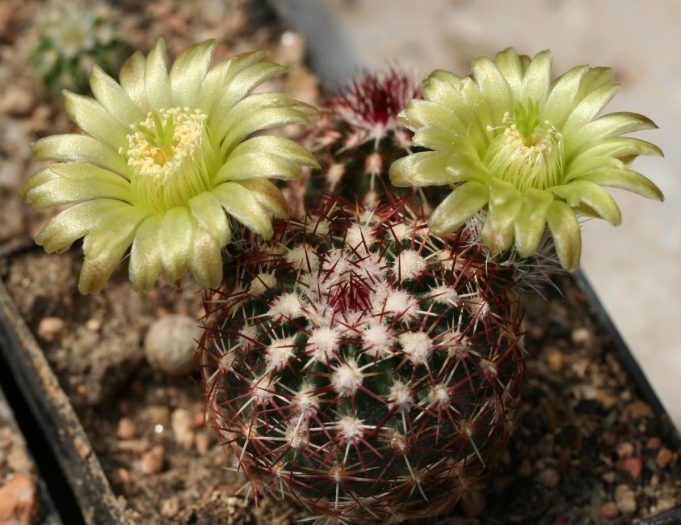Nylon Hedgehog Cactus
(Echinocereus viridiflorus)
Nylon Hedgehog Cactus (Echinocereus viridiflorus)
/
/

Michael Wolf
CC BY 2.5
Image By:
Michael Wolf
Recorded By:
Copyright:
CC BY 2.5
Copyright Notice:
Photo by: Michael Wolf | License Type: CC BY 2.5 | License URL: https://creativecommons.org/licenses/by/2.5 | Uploader: Michael w | Publisher: Wikimedia Commons | Title: Echinocereus_viridiflorus.jpg | Notes: |





















































Estimated Native Range
Summary
Echinocereus viridiflorus, commonly known as Nylon Hedgehog Cactus, is an evergreen succulent native to the grasslands, prairies, and desert regions of the Central United States. It is particularly adapted to open, arid environments where it thrives in well-drained soils. This cactus typically has a small, spherical or cylindrical stem ranging from 3 centimeters to over 30 centimeters in height and up to 9 centimeters in width. It may grow as a solitary plant or in squat clusters with several branches. The plant’s body is characterized by ridges lined with areoles from which spines emerge. These spines can be red, yellow, white, purplish, or bicolored, often with darker tips, providing the plant with a distinctive appearance.
The Nylon Hedgehog Cactus is valued for its unique form and the colorful spines that add textural interest to rock gardens and xeriscapes. It produces flowers up to 3 centimeters long, with tepals in shades of yellowish, brownish, greenish, or occasionally red, each with darker reddish midstripes. The flowers, which are quite showy, typically bloom in late winter to early spring. In cultivation, this cactus is appreciated for its drought tolerance and ease of maintenance, making it a suitable choice for low-water gardens. It requires full sun exposure and soils with fast drainage to prevent root rot. While generally disease-resistant, it can be susceptible to fungal infections if overwatered or if the humidity is too high.CC BY-SA 4.0
The Nylon Hedgehog Cactus is valued for its unique form and the colorful spines that add textural interest to rock gardens and xeriscapes. It produces flowers up to 3 centimeters long, with tepals in shades of yellowish, brownish, greenish, or occasionally red, each with darker reddish midstripes. The flowers, which are quite showy, typically bloom in late winter to early spring. In cultivation, this cactus is appreciated for its drought tolerance and ease of maintenance, making it a suitable choice for low-water gardens. It requires full sun exposure and soils with fast drainage to prevent root rot. While generally disease-resistant, it can be susceptible to fungal infections if overwatered or if the humidity is too high.CC BY-SA 4.0
Plant Description
- Plant Type: Succulent
- Height: 0.25-1 feet
- Width: 0.5-1 feet
- Growth Rate: Slow
- Flower Color: Cream, Green
- Flowering Season: Spring, Summer
- Leaf Retention: Evergreen
Growth Requirements
- Sun: Full Sun
- Water: Low, Very Low
- Drainage: Fast
Common Uses
Bee Garden, Bird Garden, Drought Tolerant, Fire Resistant, Hummingbird Garden, Low Maintenance, Showy Flowers
Natural Habitat
Grasslands, prairies, and desert regions of the Central United States
Other Names
Common Names: Green Pitaya, Small-Flowered Hedgehog Cactus
Scientific Names: , Echinocereus viridiflorus, Echinocereus chloranthus, Echinocereus viridiflorus var. viridiflorus, Cereus viridiflorus var. minor, Cereus viridiflorus var. tubulosus, Echinocereus viridiflorus var. davisiae, Echinocereus viridiflorus var. gracilispinus, Echinocereus viridiflorus var. intermedius, Echinocereus viridiflorus var. major
GBIF Accepted Name: Echinocereus viridiflorus Engelm.